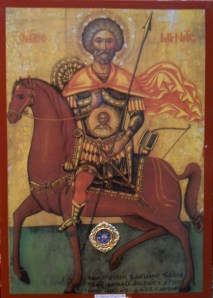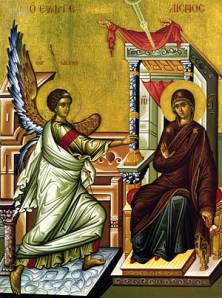The meaning of objects held by Saints in Icons

This leads us to
Weapons in icons, such as lances, shields and swords. In the first few centuries of the Church, two types of martyr gained particular devotion among Christians: virgin-martyrs and soldier-martyrs. The latter group were typically soldiers in the pagan Roman Empire who converted to Christianity and were murdered because of it. Often their conversion meant they renounced their military lives which makes their appearance in icons garbed in full armour seem strange, almost contradictory. However, if we think about St Xenia’s walking stick “transfigured” into a crosier in icons of her then things become clearer. These martyr-soldiers (and they usually hold crosses too, in remembrance of their sacrifice) have through their confession of faith become “soldiers for Christ”. As our intercessors in Heaven it is comforting, I believe, to know that there are saints warring against the “principalities of darkness” on our behalf. It is therefore natural to show those already courageous soldiers who renounced earthly weapons to even more courageously embrace death now adorned with the armour of God (Eph. 6:11-18).
~ / ~

Ss Peter and Paul are sometimes depicted together in a single Icon (they also share a feast day: June 29) and when they do they are shown together supporting a small Church Building in their hands (left). This reflects the hymnography of the Church, where the two Apostles are praised as “pillars of the Church.” Not only were they pillars of the Church, but church-builders too, establishing Christian communities (churches) around the Mediterranean and Holy Lands. Later, other Saints are remembered for their “church-building” and so are depicted holding small churches or monasteries, often in profile, shown offering the church to Christ (like the second icon of St Edwin on this page). It is quite common for Sainted kings and queens to be shown holding churches in this way, as they are honoured for their role as protector and benefactor of the Church within their lands. It is through the building up of the church that these monarchs were glorified by God, and so these buildings are the instruments of their own salvation.
~ / ~
And then there is
Jesus Christ Himself. It’s probably impious of me to refer to the Infant Christ as a “tool” of Salvation, but given the above there is much sense in seeing Mary holding Christ in the same way a holy heirarch holds a Gospel Book. The reason Christians do not chase after martyrdom is because it is not something that is sought after, but something accepted if God wills it. The martyr, the holy heirarch, the prophet, and the warrior-saint are all chosen by God to fulfill their roles, for the benefit of all. Individual Saints do not choose whether to be a wise hermit, a virgin-martyr, or an evangelist; their choice is simply to accept the role God ordained for them, or to go their own way.

And so when Archangel Gabriel delivered to the virgin Mary news that God had chosen her to be the mother of the world’s Saviour, she had the choice to accept this, or to run away. By humbly saying “be it to me according to your word”, Mary would be forevermore called full of Grace. Therefore, in most icons of her, Mary is shown holding the Infant Christ, through Whom she was glorified as the Birth-Giver (Theotokos) and Mother of God.

For the same reason as the Mother of God holds Christ in her hands, it is also right for icons of Simeon the God-Receiver to show him holding Christ. By the same reasoning it is inappropriate to show Joseph of Nazareth holding Christ. Joseph was the man betrothed to Mary, who protected her and Christ during Herod’s persecutions, and to most people was considered Jesus’ father. But he wasn’t, and is not acclaimed a Saint for being Jesus’ father. He is a saint for being the Betrothed of Mary, for protecting her and not breaking off the betrothal for infidelity. Where portrait Icons of Joseph exist (and they’re not that common) he’s usually shown holding two doves, the poor-man’s sacrifice he offered at Christ’s Presentation at the Temple (Luke 2:22–40).
There are other objects not mentioned here which are held by Saints in their “heavenly portraits”. The reasons for each object are different, but the principal is the same: the Saints hold the tools of their Salvation. The sheer number of different items depicted in Icons show us the diversity of ways in which God calls us. The Cross, the Gospel, holy Wisdom, the Church: all ultimately lead to Christ, of course, yet the richness of items points to the abundance of His Mercy and Grace.